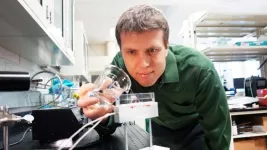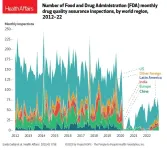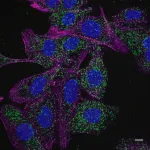(Press-News.org) Water is often the go-to resource for heat transfer, being used in large-scale cooling operations like data centers that power the internet and nuclear power plants that power cities. Discovering dynamic phenomena to make water-based heat transfer more energy and cost efficient is the ongoing work of Jonathan Boreyko, associate professor and John R. Jones III Faculty Fellow in mechanical engineering.
Boreyko and his team have published extensively on the topic of water and the way it can move, with members of his Nature-Inspired Fluids and Interfaces Lab producing water droplets that leap propelled by surface tension and frost that jumps by way of electrostatics. Having incorporated the two phases of liquid and solid in the first two volumes, their third volume investigates a third phase with boiling water.
“During my PhD research at Duke University, I discovered jumping water droplets," said Boreyko. "A decade later, my own graduate student discovered jumping ice during his research on frost growth. This made me determined to complete a three-phase “trilogy” for jumping water, which we achieved here with this paper on jumping bubbles during the boiling of water. When Hyunggon showed me the first videos of these jumping bubbles that complete the trilogy, needless to say, I was jumping with excitement.”
Graduate student Hyunggon Park created a micro-structured boiler capable of releasing bubbles at one-tenth the usual size, deploying a steady barrage of bubbles to carry energy. The result is a more efficient method of removing heat from a surface. The study was published in Advanced Functional Materials.
Building on boiling
Boiling is the most efficient way to continuously transfer heat through water. If boiling remains constant, so does the departure of energy. Energy is carried away in bubbles, like spherical cars carrying heat passengers. Those bubbles normally depart when their own buoyancy becomes stronger than surface adhesion, causing them to rise to the surface and release the energy.
Park and Boreyko's new method improves on that principle by making the fleet of bubble cars smaller and more numerous. Because there is a more constant departure of bubbles, more energy passengers are also leaving. The bubbles aren’t waiting for their own buoyancy to do the work, but they are leaping away from the heated surface at a faster rate. Because the bubbles are also microscopically small, the team has solved a breakdown that occurs with larger bubbles and stalls heat removal.
“Normally, buoyancy detaches these surface bubbles when they are millimeters in diameter, allowing them to escape and take the heat away as steam,” said Boreyko. “When boiling at higher temperatures, these large surface bubbles merge together to form a continuous vapor film. This film insulates the liquid from the hot surface, causing a breakdown in heat transfer.”
Surface-level engineering
The secret to the team’s method is found in the engineered surfaces they have created. By fabricating an array of micro-cavities onto the boiling surface, bubbles preferentially form and grow within the cavities. Pairs of cavities are intentionally placed very close together, causing neighboring bubbles to coalesce together at unusually small sizes. At such small sizes, the force of surface tension is very strong, causing the bubbles to jump away from the surface as they merge together. In the case of a data center, more rapid removal of heat from a surface could mean the difference between business as usual and costly downtime.
In many ways, this jumping-bubble effect is very similar to the jumping dew droplets previously discovered by Boreyko. The use of surface tension proved valuable in both cases, but the added factor of heat brings new dynamics into the picture.
Putting those pieces together, Boreyko expects that the jumping phenomenon will be more practical when finding widespread applications for cooling and heat transfer.
“To cause droplets to jump, the surface needs a hydrophobic coating and ultra-small nanostructures, both of which are fragile and expensive,” Boreyko explains. “In contrast, bubbles prefer jumping on a hydrophilic surface, which allows for uncoated metals to be used. Also, the micro-cavities required for jumping bubbles are much larger and more durable than the nanostructures needed for jumping droplets.”
This project lays deeper groundwork for understanding the fluid mechanics of the jumping bubble effect. The next step is measuring the improved heat transfer through boiling, mapped over a wide range of temperatures and surface geometries, to gain a better understanding of the full potential of jumping-enhanced boiling.
END
Boiled bubbles jump to carry more heat
Bubbles are an optimal way to carry heat, and Jonathan Boreyko's team has engineered a surface that makes them jump to carry even more
2023-12-04
ELSE PRESS RELEASES FROM THIS DATE:
Increase in child suicide linked to the nation’s opioid crisis
2023-12-04
The rise in child suicides in the U.S. since 2010 was fueled in part by the nation’s opioid crisis, which previous studies found increased rates of child neglect and altered household living arrangements, according to a new RAND Corporation study.
The analysis links the rise is child suicides to the reformulation of prescription opioids to discourage misuse, which led to a steep rise in the use of illicit opioids such as heroin and may have contributed to the growth of illicit opioid markets.
Geographic areas that were more exposed to ...
UCLA scientists receive $9.1 million from the NCI to improve early detection methods for cancer
2023-12-04
Researchers from the UCLA Health Jonsson Comprehensive Cancer Center have received two grants totaling $9.1 million from the National Cancer Institute to advance liquid biopsy technologies for the early detection of cancer, which can significantly improve treatment outcomes and reduce the number of deaths caused by the disease.
A liquid biopsy is a promising non-invasive medical test using a small volume of blood that gives scientists insight into the genetic makeup of tumors. By analyzing these components, researchers can gain valuable information about the genetic mutations, alterations and other molecular changes associated ...
Health Affairs’ December Issue: Global Lessons From COVID-19
2023-12-04
Washington D.C.—The December Health Affairs, a theme issue about the lessons learned around the globe from the COVID-19 pandemic, covers topics including how modeling was used to respond to the pandemic, how health inequities emerged and were addressed, and how countries tried to protect their vulnerable residents. The December issue of Health Affairs was supported by the Robert Wood Johnson Foundation and the Merck Foundation.
There will be a Health Affairs briefing on Tuesday, December 5, from 11:00 a.m. to 2:00 p.m. ET. Register here.
COVID-19, a decline in FDA foreign facility inspections.
At the start of the COVID-19 pandemic, the Food and Drug Administration (FDA) halted ...
BioOne announces Subscribe to Open Pilot
2023-12-04
WASHINGTON D.C. – BioOne, the leading nonprofit aggregator in the biological, ecological, and environmental sciences, today announces a bold plan to offer up to 80 society titles as part of a Subscribe to Open (S2O) pilot beginning in January 2026.
This decision, unanimously endorsed by the BioOne Board of Directors, follows 18 months of careful feasibility analysis and extensive interviews with BioOne’s community of society and library partners in search of an equitable and sustainable path to open.
BioOne will work with its publishing community throughout 2024 to encourage participation in the pilot, ...
Unveiling a new era of imaging: Boston University engineers lead breakthrough microscopy techniques
2023-12-04
When microscopes struggle to pick up faint signals, it’s like trying to spot subtle details in a painting or photograph without your glasses. For researchers, this makes it difficult to catch the small things happening in cells or other materials. In new research, Boston University Moustakas Chair Professor in Photonics and Optoelectronics, Dr. Ji-Xin Cheng and collaborators are creating more advanced techniques to make microscopes better at seeing tiny sample details, without needing special dyes. Their results, published in Nature Communications and Science Advances respectively, are helping scientists visualize and understand their samples in an easier ...
New wearable communication system offers potential to reduce digital health divide
2023-12-04
Wearable devices that use sensors to monitor biological signals can play an important role in health care. These devices provide valuable information that allows providers to predict, diagnose and treat a variety of conditions while improving access to care and reducing costs.
However, wearables currently require significant infrastructure – such as satellites or arrays of antennas that use cell signals – to transmit data, making many of those devices inaccessible to rural and under-resourced communities.
A group of University of Arizona researchers has set out to change that with a wearable monitoring device system that can send ...
In hotter regions, mammals seek forests, avoid human habitats
2023-12-04
The cool of the forest is a welcome escape on a hot day. This is especially true for mammals in North America’s hottest regions, according to a study from the University of California, Davis. The study indicates that, as the climate warms, preserving forest cover will be increasingly important for wildlife conservation.
The study, published today in the journal PNAS, found that North American mammals — from pumas, wolves and bears to rabbits, deer and opossums — consistently depend on forests and avoid cities, farms and other human-dominated ...
Leukemia cells activate cellular recycling program
2023-12-04
FRANKFURT. In a recent study, scientists led by Professor Stefan Müller from Goethe University’s Institute of Biochemistry II investigated a specific form of blood cancer known as acute myeloid leukemia, or AML. The disease mainly occurs in adulthood and often ends up being fatal for older patients. In about a third of AML patients, the cancer cells’ genetic material has a characteristic mutation that affects the so-called NPM1 gene, which contains the building instructions for a protein of the same name.
While it was already known that the mutated NPM1 variant (abbreviated as ...
Argonne and Idaho National Laboratories partner with CMBlu Energy for innovative long-duration energy storage project
2023-12-04
The U.S. Department of Energy’s (DOE) Argonne National Laboratory, along with Idaho National Laboratory (INL), was chosen by the agency for a demonstration project to validate an innovative long-duration energy storage system developed by battery manufacturer CMBlu Energy. The collaborative project aims to improve microgrids in cold climates and make fast charging of electric vehicles more affordable in underserved communities.
Over the course of the project, Argonne and INL will deploy and evaluate CMBlu Energy’s Organic SolidFlow™ ...
CCNY researchers publish optical data storage breakthrough in Nature Nanotechnology
2023-12-04
Physicists at The City College of New York have developed a technique with the potential to enhance optical data storage capacity in diamonds. This is possible by multiplexing the storage in the spectral domain. The research by Richard G. Monge and Tom Delord members of the Meriles Group in CCNY’s Division of Science, is entitled “Reversible optical data storage below the diffraction limit” and appears in the journal Nature Nanotechnology.
“It means that we can store many different images at the same place in the ...
LAST 30 PRESS RELEASES:
Scientists trace microplastics in fertilizer from fields to the beach
The Lancet Obstetrics, Gynecology, & Women’s Health: Taking paracetamol during pregnancy does not increase risk of autism, ADHD or intellectual disabilities, confirms new gold-standard evidence review
Taking paracetamol during pregnancy does not increase risk of autism, ADHD or intellectual disabilities
Harm reduction vending machines in New York State expand access to overdose treatment and drug test strips, UB studies confirm
University of Phoenix releases white paper on Credit for Prior Learning as a catalyst for internal mobility and retention
Canada losing track of salmon health as climate and industrial threats mount
Molecular sieve-confined Pt-FeOx catalysts achieve highly efficient reversible hydrogen cycle of methylcyclohexane-toluene
Investment in farm productivity tools key to reducing greenhouse gas
New review highlights electrochemical pathways to recover uranium from wastewater and seawater
Hidden pollutants in shale gas development raise environmental concerns, new review finds
Discarded cigarette butts transformed into high performance energy storage materials
Researchers highlight role of alternative RNA splicing in schizophrenia
NTU Singapore scientists find new way to disarm antibiotic-resistant bacteria and restore healing in chronic wounds
Research suggests nationwide racial bias in media reporting on gun violence
Revealing the cell’s nanocourier at work
Health impacts of nursing home staffing
Public views about opioid overdose and people with opioid use disorder
Age-related changes in sperm DNA may play a role in autism risk
Ambitious model fails to explain near-death experiences, experts say
Multifaceted effects of inward foreign direct investment on new venture creation
Exploring mutations that spontaneously switch on a key brain cell receptor
Two-step genome editing enables the creation of full-length humanized mouse models
Pusan National University researchers develop light-activated tissue adhesive patch for rapid, watertight neurosurgical sealing
Study finds so-called super agers tend to have at least two key genetic advantages
Brain stimulation device cleared for ADHD in the US is overall safe but ineffective
Scientists discover natural ‘brake’ that could stop harmful inflammation
Tougher solid electrolyte advances long-sought lithium metal batteries
Experts provide policy roadmap to reduce dementia risk
New 3D imaging system could address limitations of MRI, CT and ultrasound
First-in-human drug trial lowers high blood fats
[Press-News.org] Boiled bubbles jump to carry more heatBubbles are an optimal way to carry heat, and Jonathan Boreyko's team has engineered a surface that makes them jump to carry even more



